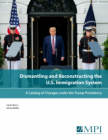U.S. Immigration Policy Program
Recent Activity

This conversation, featuring a former U.S. Census Bureau director and other top experts, examines how the many challenges facing the 2020 Census could affect the count and representation of immigrant communities, the difficulties inherent in data matching to determine legal status, and the legal and constitutional issues surrounding the administration’s actions.

Marking the launch of a report on changed USCIS procedures that appear to be adding hurdles to the citizenship process, this discussion featuring a former USCIS Director also examines the effects that the pandemic-related shutdown and a possible furlough of two-thirds of USCIS staff could have on the ability of would-be Americans to take the oath of citizenship.

Amid rising Central American migration to the United States, the U.S. and Mexican governments in June 2019 signed a joint declaration pledging to work together to manage and reduce irregular migration. At the agreement’s one-year anniversary, MPI researchers engaged in discussion with former U.S. and Mexican Ambassadors and a veteran journalist about the changes sparked.

In this bipartisan discussion, two border-state members of Congress—Rep. Veronica Escobar and Rep. Dan Crenshaw—discuss the response to the coronavirus outbreak, how it is affecting the interconnected border region, and what the future might hold.

MPI and MPI Europe experts discuss the effects of the coronavirus pandemic on asylum systems in Europe and North America, as well as in developing regions, where 85 percent of refugees live. During this freeform conversation, our analysts also assess the implications for the principle of asylum and the future for a post-World War II humanitarian protection system that is under threat.
Pages
Recent Activity
Si bien se ha prestado mucha atención a los centroamericanos recién llegados a la frontera entre los Estados Unidos y México, casi la mitad de los aproximadamente 3.5 millones que vivían en los Estados Unidos en 2017 llegaron antes de 2000. Aproximadamente un tercio son ciudadanos estadounidenses y tienden a participar en la fuerza laboral con más frecuencia que otros extranjeros y estadounidenses. Descubra más en este artículo lleno de datos.






































As Europe and the United States Face Similar Migration Challenges, Spain Can Act as a Bridge
Spain and the United States both receive their greatest number of immigrants from Latin America, and have worked collaboratively together on displacement crises and other migration issues. As shared immigration challenges dominate debate on both sides of the Atlantic, Spain can serve as a vital bridge in the policy conversation, this commentary notes.
Continue reading